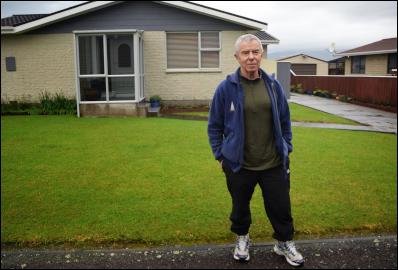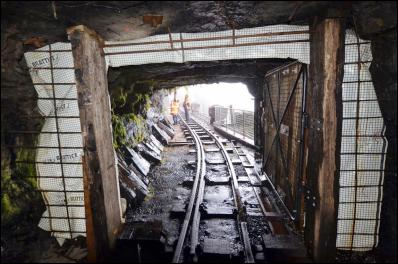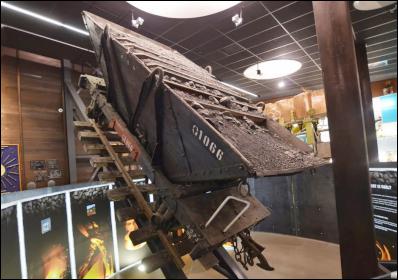Westport: Past, Present And Future
An editorial series presented by Scoop Amplifier
Part 1 - WHERE - At
the Crossroads in Coaltown
Part 2 - WHO -
The Pain Of "Uncertainty"
Part 3 - WHAT -
Denniston's "Caviar" Of Coal?
Part 4 - HOW -
Hamish Bohannan's Hopes for Westport

The town of Westport as seen from the Denniston Plateau
One way or another it’s a fact that the past, present and future of Westport and the Buller District is inextricably linked to the ground-covered seams and coal-fields on the lofty cloud-draped plateaus directly outside the township’s front door.
On the cusp of a weather bomb that hit New Zealand on June 20, Scoop Amplifier paid a 3-day visit to this enduring part of the nation to begin to gain some on-the-spot perspectives into just how steep a battle the majority of Coasters are facing to find ways to tell the story of their intertwined environmental and economic prospects. One month later, Scoop is publishing a series of feature articles to better inform a wider audience about the lie of the land in Buller, to provide a deeper factual background, and to outline who’s saying what about the role of coal mining.
First and foremost we can best do this by relaying the words of the people who call Westport and Buller their home. The series will also feature an industry point of view - from Hamish Bohannan, CEO of Bathurst Resources Ltd - and a factual exposition about the nature of the coal found on the West Coast by technology writer Peter Kerr.
This featured series will close with an editorial opinion piece by Scoop's Alastair Thompson.
Further articles in response to this series will be welcomed.
Declaration: Scoop Amplifier's
production, travel and logistical costs to and from Westport
in order to produce this series were paid for by Buller Coal
(owned by Bathurst Resources Limited). A strict protocol for
the purposes of editorial freedom was agreed. Scoop
Amplifier is a business unit of Scoop Media. Please send
feedback on this story to WestportStory@scoop.co.nz
At the Crossroads in Coaltown
: The Westport Story, part 1
Travelling through time and
place in the Buller District
Interviews, images and words By Alastair Thompson and Stephen Olsen
You really know you’ve arrived on the Coast when you meet someone who was born on the Denniston Plateau, popularised a decade ago in Jenny Pattrick’s best-selling novels The Denniston Rose and Heart of Coal.
For Scoop Amplifier’s time in Westport that moment came on a first day of a contrasting journey from the world-class Denniston Experience to the large-scale mining operations at Stockton, and ending at Palmerston Street’s new jewel in the crown, the Coal Town Museum.
Scoop’s initial host up to Denniston was Gary Bainbridge.
Born on the Denniston Plateau in January 1945, Gary is happy to be called an ‘old school’ miner. Recently retired after 51 years with Solid Energy and its state-run predecessors, he is keeping his hand in as a safety consultant and regularly passes through his birthplace on hunting trips into the hinterland.

Denniston born miner Gary Bainbridge outside his Westport home
Gary’s memories of living in a unique and celebrated mining settlement aren’t cast in black and white; they’re full of colourful recollections.
Walking with Gary and Denniston Experience tour guide Liz McDonald to an historic underground mine was a case in point.
Half way along a rail line to the mine, Gary stops and, despite the regrowth of ground covering, draws our attention to an old pathway he knew from his boyhood as Jacob’s Ladder.
“When I grew up here the Primary School had about 100 children and this was our playground”.
One of Gary’s sons is now the fifth generation of miners in the family, albeit working in Australia in open cast mining in the Hunter Valley. Gary is hopeful that his one-year-old grandson Samuel James Bainbridge will cross the Tasman to Westport at some point in the future, to experience what was once the hardy township of Denniston and to see the pathways that Gary trod and played on as a boy.
While amazingly few signs remain of the original township vacated a mere half century ago, the house that Gary grew up in is one of two isolated homes that are still standing and occupied.
The wider history is currently preserved for posterity by way of an information-rich visual display mounted by the Department of Conservation (DOC), and the nearby Denniston Experience business enterprise which exposes visitors and tourists to the form of underground mining that began on the plateau in the 19th century.
Youtube Video : Retired miner Gary Bainbridge interviewed at his Westport home - includes recollections of life at Dennisron and views on the future of mining in the Buller District.
The Denniston Experience’s central attraction is to take people through a mine that has been open since 1879 and that was used as a main thoroughfare for many years.
Once underground it reveals the limitations of this form of exploratory mining and extraction, as well as being an object lesson in the geology of coal seams that were carved out between precise horizontal layers.
The story the mine tells is more social than economic – sealed off with a hologram show that evokes the Union-based worker ethos of being a member of a mining community, and the palpable risks associated with underground mining over the years, even in a non-gaseous environment.
Gary knows Denniston and underground mining like the back of his hand. "We've been back underground (here) with new technologies to take out what we could. It got too dirty to mine in terms of stones and rock. For me now, (the future is) open cast".
He has watched shifts in mining techniques closely. "The environment (vegetation) has to be put back in as good a state if not better. That's the way you have to look at it these days. There's a lot of acid drainage up there out of the old workings that's going into the creeks and rivers now that is bad, and that people would like to see fixed".

The Banbury Mine portal - the entrance to the original Banbury mine is now the entrance to the Denniston Experience
STOCKTON
The contrast between experiencing an underground mine compared to an opencast mine is literally like night and day.
Visible scale is another matter. At first, entering Stockton - to the northwest of Denniston - is like arriving on another planet, and moreso on a day of dense fog.

The Millerton pit in the Stockton Mine - in this pit Solid Energy is reworking - using open cast techniques - the seam which was mined using underground methods for most of the past century
Phil Rossiter, an environmental manager with Solid Energy, certainly acknowledges that at a total perimeter encompassing 2300 hectares, the Stockton site – now approaching 150 years of licenced mining – operates at a scale unlikely to be seen again.
Acting as Scoop’s guide Phil conducted a three hour travail around what was as much a massive and round-the-clock caravan of excavating brown soil and rock – known as overburden – as the treasured black coking coal that Stockton and Denniston are famous for.
In his time at Stockton, Phil has come to know every aspect of the conjoined but pepper potted sites that collectively make up the Buller coal fields.
He is also an expert on the more environmentally conscious and remedial trajectory that Stockton has been on. This started not long after he joined the company in 2005, initially focused on health and safety. Implementing practices such as blackwater treatment that improves downstream river health has continued under the Stockton Alliance formed in 2009.
Phil isn’t alone in identifying strongly with the social geography, heritage and vegetation aspects of mining on the Coast.
A difference is that he has years of hands-on experience in techniques like Vegetation Direct Transfer (VDT), and years of explaining finer details of the disturbance caused by mining to lay people and experts alike in neutral-factual terms intended to dispel over-generalisations.
Some things are obvious, and others need analogies to help explain them.
On the plateau the stunted plant growth is due to low solar radiation and lack of fertile soil. This creates an adaptive form of vegetation that can survive an extreme climate likely to include up to 6 metres of rain in a year, and that results in what might be called “bonsai” versions of plants.

Stockton Alliance's Phil Rossiter near the summit of Mt Augustus where VDT "Vegetation Direct Transfer" has been used to recreate the unique eco-system and snails have been returned
Mining sites that remain at Stockton will, in the foreseeable future, largely entail reworking old workings on brownfield sites like the Millerton – accompanied by moves to extinguish a resistant underground fire that Phil likens to Dante’s inferno.
Only completely new sites would allow a complete whole-of-life approach and open cast mining of more “dental precision”.
Time and again a faulty assumption to make is that all coal is the same. Phil agrees that for urban café dwellers, this naïve view about the uniform same-ness of coal would be the equivalent of lumping all types and origins of coffee together.
The underpinning fact being that the metallurgical coking coal extracted in Buller for steel making, bears no resemblance to thermal coal used as fuel in coal-burning power stations.
All coal originates from the composition and mineralisation of swampy vegetation from previous millennia.
It can’t be made to order. And it just so happens that Buller coal is in a state that is so highly regarded that it gets likened to “saffron” (or even Columbian heroin!) with minor variations that can be allocated different specifications based on levels of ash and sulphur. Bottom line: if this was thermal coal instead of coking coals with upstream technological benefit, there would be no justification for the expense of mining it.
Small but growing successes are taking place in the revegetation on dedicated land at Stockton. Most eyes will be on a reserve area next to the peak of Mt Augustus where every effort is being taken to recreate a habitat for the well documented Powelliphanta Augustus snail.
What bothers Phil Rossiter is that too few people get to witness firsthand both the undeniable scale that Stockton is beginning to peak at – where industrial plant in the form of diggers and trucks are the direct opposite of “bonsai” proportions – as balanced against the micro-surgery of seeking to wind back the clock on years of industrial disturbance.
Nothing is being hidden. Operations like Outwest Tours of Stockton are combining the sight of active mining and tourism. Yet the people seeing this first-hand and close-up, are very unlikely to ever return, let alone live in the area.
What excites Phil is that the vegetation rehab crews at Stockton are gradually increasing their expertise.
Youtube Video : taken near the summit of Mt Augustus as we visit an area of VDT "Vegetation Direct Transfer. Giant carnivorous snails had recently been released here, returned to where they previously lived.
Some of the equipment being newly engineered to translocate discrete surfaces is creating some world firsts, and adding to a knowledge base of IP in this type of work that holds potential global worth.
“Some mining has had a history of rip, shit and bust, but not here any more,” says Phil. Neither the money being put into site rehabilitation and seedling nurseries – in the millions of dollars a year - nor the value of up to 90 specialist jobs assigned to this, are insignificant as a sign of commitment to fully shelve old practices.
COALTOWN MUSEUM
Proof aplenty of both the good old days of mining gold and coal on the Coast, and some of the twists and turns along the way, is on display at Westport’s 21st century Coal Town Museum which only re-opened on the 1st of June this year.

A "Q-Wagon" on display at Coaltown Museum - these were used to take coal from the Denniston Plateau down the infamous Denniston incline
Originally established in the 70s the Museum’s new location on Palmerston Street is a complete facelift and is being kept under the watchful care of Chris Hartigan, a Coaster who first helped out at the museum when he was still a student at Buller High School.
A museum display panel states that the first European to record coal north of Westport was engineer-explorer John Rochfort in 1859. The discovery of “pure coal” was soon verified by geologist-explorer Julius Haast, who, with surveyor James Burnett named the locality Coalbrook-Dale.
Geological mapping and surveying to determine the extent of the Buller Coalfield was carried out between 1873-1878 by Robert Blair Denniston, William Cooper and S. Herbert Cox. They were supervised by Dr James Hector, famous for founding many of New Zealand’s scientific organisations.
Opencast mining began at Stockton in the 1940s. Although old mine maps for Stockton survive, they are known to be inaccurate. Today modern scanners, taking thousands of readings a second, can give exact locations and measure the volume of various man-made mountains. Having an accurate survey that both company and contractor can agree on is fundamental to a mine’s operation.
The Millerton and Mangatini workings at Stockton are in an area famous for the size of its coal seams – up to 12 metres thick in some places. Today a 2.5 kilometre aerial ropeway carries coal down to sea level at Ngakawau where up to six trains a day take it to Lyttelton for export.
Over its history some 16 separate mines are shown to have opened and closed at Stockton and north Buller; with closures in every decade of the 20th century except for the 1920s, 40s and 90s.
From Hartigan’s point of view, the consents required for more mining will come, and compliance with conditions will balance out the impacts of mining.
“So, what they have come up with at Denniston is a win win for everybody,” he says. “We can’t do without coal. We need it for steel production, we need it for carbon fibre, you need it for the graphite that you get from coal for your filters for water. You need it in all sorts of things. It's not all about power generation, it's not all burnt.”
Youtube Video : Interview with Coaltown Museum's Chris Hartigan
(continuing story...)
This story is being published in four parts starting July 31st 2013.
Declaration: Scoop
Amplifier's production, travel and logistical costs to and
from Westport in order to produce this series were paid for
by Buller Coal (owned by Bathurst Resources Limited). A
strict protocol for the purposes of editorial freedom was
agreed. Scoop Amplifier is a business unit of Scoop Media.
Please send feedback on this story to WestportStory@scoop.co.nz




 Binoy Kampmark: The Inevitable Souring - Elon Musk Falls Out With Donald Trump
Binoy Kampmark: The Inevitable Souring - Elon Musk Falls Out With Donald Trump Ian Powell: Postscript On Ethnic Cleansing, Genocide And New Zealand Recognition Of Palestine
Ian Powell: Postscript On Ethnic Cleansing, Genocide And New Zealand Recognition Of Palestine Gordon Campbell: On Why Leakers Are Essential To The Public Good
Gordon Campbell: On Why Leakers Are Essential To The Public Good Ramzy Baroud: Global Backlash - How The World Could Shift Israel's Gaza Strategy
Ramzy Baroud: Global Backlash - How The World Could Shift Israel's Gaza Strategy DC Harding: In The Spirit Of Natural Justice
DC Harding: In The Spirit Of Natural Justice Martin LeFevre - Meditations: Animal Encounters During Meditative States
Martin LeFevre - Meditations: Animal Encounters During Meditative States